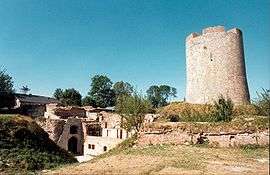Guise
| Guise | ||
|---|---|---|
|
Dungeon and basse court of the Château de Guise | ||
| ||
 Guise | ||
|
Location within Picardy region  Guise | ||
| Coordinates: 49°54′03″N 3°37′42″E / 49.9008°N 3.6283°ECoordinates: 49°54′03″N 3°37′42″E / 49.9008°N 3.6283°E | ||
| Country | France | |
| Region | Nord-Pas-de-Calais-Picardie | |
| Department | Aisne | |
| Arrondissement | Vervins | |
| Canton | Guise | |
| Government | ||
| • Mayor (2008–2014) | Hugues Cochet | |
| Area1 | 16.13 km2 (6.23 sq mi) | |
| Population (2012)2 | 5,182 | |
| • Density | 320/km2 (830/sq mi) | |
| INSEE/Postal code | 02361 / 02120 | |
| Elevation |
91–157 m (299–515 ft) (avg. 97 m or 318 ft) | |
|
1 French Land Register data, which excludes lakes, ponds, glaciers > 1 km² (0.386 sq mi or 247 acres) and river estuaries. 2 Population without double counting: residents of multiple communes (e.g., students and military personnel) only counted once. | ||
Guise is a commune in the Aisne department in Picardy in northern France.
Population
| Historical population | ||
|---|---|---|
| Year | Pop. | ±% |
| 1793 | 3,085 | — |
| 1800 | 3,039 | −1.5% |
| 1806 | 3,097 | +1.9% |
| 1821 | 2,729 | −11.9% |
| 1831 | 3,072 | +12.6% |
| 1836 | 3,241 | +5.5% |
| 1841 | 3,543 | +9.3% |
| 1846 | 3,528 | −0.4% |
| 1851 | 4,060 | +15.1% |
| 1856 | 3,684 | −9.3% |
| 1861 | 4,529 | +22.9% |
| 1866 | 5,289 | +16.8% |
| 1872 | 5,659 | +7.0% |
| 1876 | 6,250 | +10.4% |
| 1881 | 7,131 | +14.1% |
| 1886 | 7,677 | +7.7% |
| 1891 | 8,153 | +6.2% |
| 1896 | 8,082 | −0.9% |
| 1901 | 7,310 | −9.6% |
| 1906 | 7,776 | +6.4% |
| 1911 | 8,099 | +4.2% |
| 1921 | 6,185 | −23.6% |
| 1926 | 7,097 | +14.7% |
| 1931 | 7,110 | +0.2% |
| 1936 | 6,981 | −1.8% |
| 1946 | 6,031 | −13.6% |
| 1954 | 6,091 | +1.0% |
| 1962 | 6,284 | +3.2% |
| 1968 | 6,805 | +8.3% |
| 1975 | 6,642 | −2.4% |
| 1982 | 6,195 | −6.7% |
| 1990 | 5,976 | −3.5% |
| 1999 | 5,896 | −1.3% |
| 2008 | 5,365 | −9.0% |
| 2012 | 5,182 | −3.4% |
Sights
The ruins of the medieval castle of Guise, seat of the Dukes of Guise, are located in the commune.
Economy
Guise is the agricultural centre of the northern area of Aisne.
Miscellaneous
Guise was the birthplace of Camille Desmoulins (1760–1794), a journalist and politician who played an important part in the French Revolution.
Over a period of 20 years, beginning about 1856, Jean-Baptiste Godin built Le Familistère (the Social Palace), an industrial and communal residential complex that was a separate community within Guise. It expressed many of his ideas about developing social sympathy through improved housing and services for workers and their families, influenced by the ideas of the philosopher Charles Fourier. In 1880 Godin created a cooperative association by which the workers owned and managed the complex. This continued until 1968.
On the 29th of August 1914 the Battle of St. Quentin (1914) was fought in and around the town. A memorial in Guise celebrates this event.
See also
References
| Wikimedia Commons has media related to Guise. |
|

